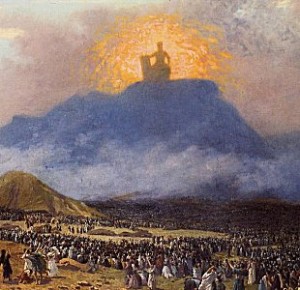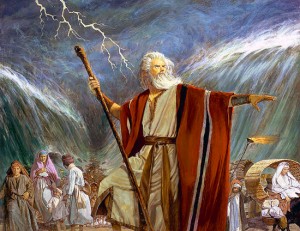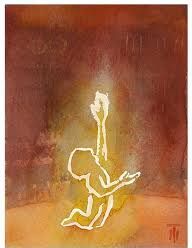Foundations for World Spirituality: Learning the Language of God (Part 4 of 5)
Editor’s note: The following essay by Marc Gafni is published as a white paper of the Center for Integral Wisdom think tank. Our Spirit’s Next Move blog is pleased to announce the paper’s availability.
Ten Words to Live By
The second biblical myth word symbol of freedom is actually mistranslated into English as the Ten Commandments. The people, so the story goes, having fled Egypt, gather at the foot of Mount Sinai to receive the Ten Commandments. Of course, nowhere in the biblical myth is there any mention of Ten Commandments. Here is where the old witty maxim, “Reading the bible in translation is like kissing a woman through a veil,” becomes not altogether untrue. In the original Hebrew, the people receive at Sinai not Ten Commandments but “Ten Words.” Here Voice becomes Word, the articulation of speech. It is the beginning of the vision that follows revolution.
The third word symbol is no less than the word “Messiah.” “Messiah” in the original Hebrew is understood by the Kabbalists, quite astoundingly, to mean “conversation.” Master Nachum of Chernobyl, mystic and philosopher, points out that the Hebrew word for messiah, Mashiach, can be understood as the Hebrew word Ma-siach – meaning “from dialogue” or “of conversation.” His assertion radically implies that the Messiah is potentially present in every human conversation””every mutual act of voice-giving.
All authentic conversation is sacred conversation. The ability to have an honest face-to-face talk in which both sides are true to themselves, vulnerable and powerful at the same time, is Messianic.
Simply put, sacred conversation is the vessel that receives the light of Messiah.
Sounds of Silence
The soul print of the emancipated storyteller is not entirely realized with the move from mute silence to sacred speech. It goes one rung higher, for soul print journeys are not only linear but circular, taking us spiraling upward and beyond. The path takes us from silence to speech and then back–to a higher silence that will birth a higher speech.
We return to the most famous biblical myth image of speech–the “Ten Words” spoken at Sinai. The Kabbalists, as you by now expect, have a different interpretation. In fact, according to the Kabbalists, God had nothing special to say that particular morning. God said what God says every day! “I am here,” he said. “I am present. The world is meaningful. Every human being is created in my image and therefore has infinite value and dignity.” In the language of the Kabbalists, “A voice issues forth daily from Sinai saying, ”˜I am the Lord your God.’” This is not a statement of theology but an affirmation of meaning and relationship based on voices in sacred conversation.
On that auspicious day at Sinai, we heard a voice not so much because God spoke, but because we listened. We got quiet. So did the whole world. In the wonderful imagery of the third century myth masters, “On the day of revelation a bird did not chirp, an angel did not sing, an ox did not bellow, the sea did not rage – the entire world fell silent”¦and the voice at Sinai was heard.”
The voice can be heard only from the silence.
This post is part of a series of posts “Foundations for World Spirituality: Learning the Language of God” which begins with Part 1. For Part 2, Part 3, and Part 5, follow the links.
Unique Self Dialogue: Ken Wilber & Marc Gafni, Part 2
The page you are trying to reach is part of our Great Library Stacks & Archives. If you already signed up for our FREE Great Library card, please log in to access this content.
If you are not yet a Library Card owner, you can sign up to get access.
Daily Wisdom: Victims and Pseudo-Victims
 The pseudo-victim has genuine options which she refuses to action; she refuses to turn fate into destiny and cries more than it hurts. Another kind of pseudo-victim also may have some level of real hurt but more often than not the hurt is more imagined than real and being a victim is a freely chosen role which has many hidden benefits which the pseudo-victim seeks to exploit. The hidden victims of pseudo-victims therefore are real victims.
The pseudo-victim has genuine options which she refuses to action; she refuses to turn fate into destiny and cries more than it hurts. Another kind of pseudo-victim also may have some level of real hurt but more often than not the hurt is more imagined than real and being a victim is a freely chosen role which has many hidden benefits which the pseudo-victim seeks to exploit. The hidden victims of pseudo-victims therefore are real victims.
The underlying dogma of the Culture of Victimization is the location of human evil outside the human being. This belief significantly undermines the God field. The premise is simply that since human beings are naturally good, all evil must be the result of some external force which warps natural human goodness. The argument between the very many streams of thought who affirm this position is merely about which cause, external to the person, actually is the major factor in causing evil. For Marxists, it is the capitalist structure of economies and societies; for the staunch Republican it might be big government or television violence or liberals. For liberals it might be the old church or handguns or patriarchy.
Marc Gafni, The Dance of Tears
Foundations for World Spirituality: Learning the Language of God (Part 3 of 5)
 By Marc Gafni
By Marc Gafni
Editor’s note: The following essay is published as a white paper of the Center for World Spirituality think tank. Our Spirit’s Next Move blog is pleased to announce the paper’s availability.
The Second Stage: from Silence to Sound
The beginning of freedom is the emergence of voice. This stage is expressed both by the initial cry of the Israelite slaves that broke their silence, as well as by Moses’ arrival on the scene. “When Moses came, voice came,” writes the Zohar. Moses does what the charismatic revolutionary always does: he gives voice to the people. Indeed, biblical myth text records the beginning of redemption with the following words: “”It came to pass in the course of many days that the King of Egypt died and the children of Israel sighed by reason of the bondage and they cried out and their cry came up unto God.” The enslaved Israelites are received by the presence of God at the point when they move from the dumb silence of the slave to sound which is the beginning of speech, the characteristic of a free people. This “cry” is not an elegantly articulated protest – it is a cry as in the cry of a wolf, or the cry of an infant. It is primal, impassioned, pre-civilized, a howl of protest that makes it into the halls of heaven, heard by God himself.
For the first time the enslaved can express distress. They seek to articulate words that are not yet ready to form themselves on their lips. At this stage of moving toward freedom, we do not yet know how to tell our story. We do not know what we would do with the world if it were given over to our stewardship. We just know that we must protest.
The biblical myth symbol (Leviticus 25) for the transition from slavery to freedom is the primal blast of a ram’s horn. No trumpet of gold, it is rather the rawness of the ram’s horn that captures the slave’s first fitful sounds. The first thing a revolutionary movement must do is sound its ram horn–start a newspaper, set up a radio station, build an internet site. It is not by accident that the fundamentalist and totalitarian states are trying to disallow or severely limit internet access. Freedom’s beginnings are expressed in the first shouts of protest.
The sixties and seventies were such second-stage revolutionary generations. This helps explain why so many sixties hippies became late seventies and early eighties yuppies and then transformed again into the establishment of the nineties. The feeling of distress generated protest – sound and even the first glimmerings of voice–but there was no alternative vision of society to generate “speech.” Similarly, many third world revolutionaries reflect such second stage thinking. Consequently, as we all know, that not a few third world revolutionaries became the leaders of far more repressive regimes than the ones they overthrew. Because they lacked speech to articulate the primal manifestations of voice, they needed to repress all of their own pain, the very distress and disease that initially led to the revolution.
What can they do when the revolution has happened and the dis-ease remains? Only two choices are available. The revolutionary can choose to look inside personal and societal soul in a very profound way, attempting to wrestle with the dis-ease at its source and not merely on a symptomatic level. This would involve addressing the ills of society that provoked revolution–through the creation of a new society with just laws and a conceptual framework to insure the continued freedom of the people. This is the move from primal voice to speech. Or the revolutionary can lash out to avoid the necessity of confronting his own emptiness. Lashing out is always easier but not a stage of growth. It continues and repeats the stage-two voice of protest. The repression it produces is often brutal and animalistic.
Like all stages of growth – stage two is necessary and positive when it is part of a process. Arrested growth, however, always produces some form of pathology.
The Third Stage: From Sound to Word
In the third stage, voice gives birth to word. Now we are able to tell our story – to speak authentically with each other, to articulate clearly both our needs and our visions of a better world. A rebel newspaper is no longer sufficient. Only in the writing of a constitution or a Declaration of Independence is the next stage of freedom achieved. Or in the case of the sixties, a spiritual movement needed to be born which attempts, however imperfectly, to write the books of a New Age.
Three biblical myth word symbols capture this third stage in mystical consciousness.
The first word symbol is called in Hebrew the haggadah””literally, “the story telling.” This is the very name of the myth text we read from at Pe-Sach, when we reclaim our story. By assuming authorship of our stories, we assert spiritual authority over our lives. We are no longer subject to will and directive of the taskmaster, priest, or rabbi. By becoming authors of our own haggadah, we progress past the protest and actually become free.
The master Kalonymous Kalman explains that the demarcating characteristic of messianic times is that every person will be his or her own spiritual master. This is his radical reading of the biblical myth vision expressed by prophet Jeremiah “And no man will anymore learn from his fellow to know God, for everyone will know Me from the wise to the simple.” Every person will find voice and articulate speech and those words will be his or her spiritual guide. In the end, we will discover that we are the sacred book and the sacred book is us. In fact, there is a tradition in Jewish prayer to take the Torah scrolls adorned with crowns of silver and fine cloth and carry them around the prayer room, allowing everyone to touch and kiss them. Where I pray, we started a tradition of also kissing the person chosen to carry the scrolls, recognizing that she too is a sacred scroll.
This post is part of a series of posts “Foundations for World Spirituality: Learning the Language of God” which begins with Part 1. For Part 2, Part 4, and Part 5, follow the links.
Daily Wisdom: Tears contain the methodology for the evolution of God
Today’s Daily Wisdom:
The ultimate revelation of tears of transformation is the revelation of nonduality. For the kabbalist, it is within the power of tears to create divinity…
To read the full passage from “The Dance of Tears,” see MarcGafni.com.
World Spirituality Unplugged: “What’s love got to do with business?: John Mackey and Marc Gafni in Dialogue, Part 1”
 World Spirituality Unplugged is a regular new column on this website which will feature highlights from the Center for World Spirituality’s substantial audio and video archives which are more relevant than ever before. The short clip posted here (about 5 minutes) features an excerpt from a dialogue between John Mackey and Marc Gafni, recorded in 2010 for the Future of Love Teleseries, an online event for which CWS was a co-sponsor.
World Spirituality Unplugged is a regular new column on this website which will feature highlights from the Center for World Spirituality’s substantial audio and video archives which are more relevant than ever before. The short clip posted here (about 5 minutes) features an excerpt from a dialogue between John Mackey and Marc Gafni, recorded in 2010 for the Future of Love Teleseries, an online event for which CWS was a co-sponsor.
Marc Gafni, as you are well aware, is the Director and Scholar-in-Residence for the Center. John Mackey is not only the Chairman and CEO of a $4 billion Fortune 500 company, he is also Co-Chair of the Board of the Center for World Spirituality. Mackey was named the Ernst and Young Entrepreneur Of The Year in 2003. John is a strong believer in FLOW principles, including free market principles and empowerment management. He is also one of the most influential advocates in the movement for organic food. Whole Foods was the first grocery chain to set standards for humane animal treatment.
Early in the dialogue, John Mackey offers a definition of business that situates it right at the heart of human care and concern:
Marc: As we talk about love today, we’re talking about it not from a Christian perspective, or from a Jewish perspective, or from a Muslim perspective, or a Buddhist, or a Taoist, or a Native American, we’re talking about a perspective which transcends and includes them. And by “transcend,” I mean trance-end. We end the trance of one particular understanding, we receive what’s best and deepest in it, and link it with an understanding of the understandings available all over the globe and history, in a way that was never really available before. That’s the context that we’re talking about. We’re not going to be referring to it any more today. In that context, from that place, we’re talking about love and business, love and commerce, love and capitalism.
When the average person walks down the street and thinks about love and then they think about business, they think what do those things have to do with each other. Business: isn’t that about making profit? Love: that’s that spirit feeling that I have that’s all about sacrifice, things that have little to do with the material. We got a few emails from people saying: Love and Business? What’s that about? We wrote back: Tune in and listen and find out.
It’s delightful to be with you. What would your response be to those people? How does love actually act and show up in 1st, 2nd, and 3rd person? 1st – love that you feel moving through you; 2nd – interpersonal love, love in the space of the We; 3rd – love as the force of the universe. How does that show up in the world of commerce and business. John, be our teacher.
John: Okay, Marc. It’s sort of an odd question: what does love have to do with business? There’s sort of an assumption that business and commerce and capitalism are not fully human activities. That they are held apart in some way. That’s part of the problem. We have this stereotype of business based on metaphors of greed and selfishness based on this belief that it’s all about profit and money, and therefore it’s less than human. If that’s really what business is, then I think people would be right to condemn it. But that’s not been my experience with business. Business is as much a human activity as anything else. Human are engaging in it. Love is appropriate in business. In fact, love is essential in business if it’s going to reach its full potential.
Marc: Say more about that, John. You’re saying that love lives in business. Love is one of the natural human activities, so this split is a false split. From your own personal experience or from a meta-frame, how does love show up as a force or deep factor as you do business?
John: The first thing to understand is that business is almost always done as community, meaning a business or company is a group of people that are working together. They are working together to create value for other people. In fact, the very essence of what business is is voluntary exchange creating value for other people. That’s not only ethical, but when you go down to the roots it is a profoundly loving act – it can be and should be. We create about other people, and we’re cooperating in order to create value for them. I see business as fundamentally based on voluntary exchange between people for mutual benefit. A company has employees that work together, creating value for customers. Customers exchange voluntarily for a business. That exchange creates value for the suppliers that are exchanging with the business, which creates value for investors. The whole activity of commerce, when you move away from the caricature, you discover that at its root it is people in community creating value for each other. That can be and should be a profound act of love, care, and compassion.
Marc: What a gorgeous definition of business!
Listen to the whole audio for Part 1.
Foundations for World Spirituality: Learning the Language of God (Part 2 of 5)
Editor’s note: The following essay is published as a white paper of the Center for Integral Wisdom think tank. Our Spirit’s Next Move blog is pleased to announce the paper’s availability.
 The First Stage: The Silence of Absence
The First Stage: The Silence of Absence
The aforementioned passage in the Zohar (Exodus 25a) suggests that there are three distinct stages in the continuum from slavery to freedom. The first stage is silence. The second stage involves moving from silence to sound without speech. And the third stage is speech–voice and articulated word.
In the first stage, slavery, we are mute and dumb. We live our lives without ever really crying out. The routines of the everyday deaden our sense of injustice, and our passions atrophy amid the narrowness of Egypt, when all sounds are smothered in our throats. In the biblical myth, the people were silent in the first stage of exile in Egypt. The pain broke their spirits and they became mute–no longer able to even cry out, much less to express the injustices with the eloquence of speech. We all have touched a fraction of that experience when, after a protracted argument, we are so worn down that we lack the strength to protest even the most blatant offenses of those who oppose or oppress us.
In a less familiar reading of the biblical story, Talmudic masters suggest that the slavery in Egypt was not of the usual kind. In fact, the Israelites were successful and prosperous. However, the deadening quality and comfort of their routine had anesthetized the sensitivity to their own wounds of alienation. How many of us suffer and hurt, yet remain fundamentally unaware of our suffering, deadened by the soma pills of the expected, and the narrow straits of success?
The disease of leprosy in the ancient world was considered so horrible not just because it caused extreme disfigurement. That was only a side effect. The agent of the disease itself was a bacteria called Hansen’s Bacillus, which destroyed the nerve fibers carrying the sensation of pain. In this painless state, a person could continue walking on a broken leg, thus causing irreparable damage and further disfigurement–and even greater estrangement from the world at large.
To be numb to pain is to be prone to a deeper damage. The anesthetizing effect of unbearable agony (or apathy) can be the most devastating enemy of all. The biblical slaves were broken bones being pressed with burdens they could not hold””and their nerve endings went numb to the weight. Their enslavement was complete when they “lost their nerve” to act up, and to cry out.
Biblical myth writer Y. L. Peretz, writing at the turn of the last century, tells the story of Bonsche the Silent.
All the heavens were in an uproar. Bonsche the Silent, the most righteous man, had died. Bonsche, who never complained and always accepted his fate with graceful silence, was coming to heaven– what a day! The angels exuberantly recounted the tales of humility of this silent saintly man–how he never asked for anything, was always simple, accepting, and sublimely silent! The angels rolled out the reddest celestial carpet they could conjure; the other celestial hosts were eager to honor their celebrity; and even God was getting involved.
On his arrival to heaven, Bonsche was granted a meeting with God. This was more than unusual – it was never done–but for holy Bonsche an exception was made. He came before the throne and heard the divine voice say, “Ask for anything. Anything you want is yours.”
Never had the celestial hosts heard anything like it. Every ear strained to hear – what would Bonsche say?
Bonsche was a little overwhelmed by all the attention. After all, he viewed himself as a simple man. He responded to God,. “It would be wonderful if I could have a roll and butter every day.”
When my Buddhist brothers heard this story, they went wild. What a Satori story, they said, what an example of total detachment and simplicity, the reduction of all expectations, the giving up of desire even when God offers you everything! Yet the biblical myth perspective reads this story differently. We say”–What a shmuck”! God offered Bonsche everything and all he could think to ask for is a bagel and butter? If he wanted nothing for himself, then what of a world which suffers so? For them as well he could think of nothing to ask? Master or not, was he so absent from himself that he also no longer feel the joy or pain of other?
Indeed, we biblical myth readers look at his life of silence and view it as a tragedy. Bonsche is totally disconnected from his own needs–from his own story. He is called Bonsche the Silent one because he has no voice. His silence is a Silence of Absence. It emmanates from the void and is a violation of divine presence.
The Disguises of Silence
How does this first level of slavery-silence play in our lives? Where do we hear the sounds of silence? One of the subtlest disguises of silence can be speech.
All of us, through fear or habit, create boxes of clarity for ourselves that reassure yet limit us. Mendel of Kutzk pleads with us to remember that the hebrew world for ”˜letter’ – the basic building block of speech is Teivah- not accidentally precisely the same hebrew word which means enclosure or box.
The loss of meaning that comes with the familiarity of speech is one of the subtler and therefore more insidious boxes of the human spirit. Words, with all of their power to reveal, can become hiding places through overuse. Once words and turns-of-phrase become familiar, they lose their associative depth and their power to lead us to the experience they represent. How many twentieth-century tired cliches were the dazzling wordplays of the Elizabethans? When it first appeared in Hamlet, Shakespeare’s coining of a term like the “mind’s eye” was an original, compact, and evocative condensation of a more internal form of perception. Now the phrase is the stuff of hack journalists and junk novelists. Speech can be nothing more than a noisy kind of silence.
Too often speech about emotions becomes the way to move away from feeling. We can define and redefine vulnerability through words until the truth of what we describe fades away. Too often we get lost in routine speak which, in the language of the mystics, has the quality of noise but lacks the quality of sound. In essence, it is silence”silence of absence.
This post is part of a series of posts “Foundations for World Spirituality: Learning the Language of God” which begins with Part 1. For Part 3, Part 4, and Part 5, follow the links.
What is pleasure? A short dharma talk with Marc Gafni
The page you are trying to reach is part of our Great Library Stacks & Archives. If you already signed up for our FREE Great Library card, please log in to access this content.
If you are not yet a Library Card owner, you can sign up to get access.
Daily Wisdom: Appreciating our purple trees
Today’s Daily Wisdom by Marc Gafni:
There is a tale that educators love about the girl who paints a purple tree. The teacher, who has drawn a tree on the board and asked the children to copy it, is disapproving. “You didn’t copy my tree.”
“I know,” says the girl. “I drew my tree.”
Read more… (from Your Unique Self)
Dr. Marc Gafni: Foundations for World Spirituality: Learning the Language of God (Part 1 of 5)
Editor’s note: This is the first part of 5-part essay, published as a white paper of the Center for Integral Wisdom think tank. For Part 2, Part 3, Part 4, and Part 5, follow the links.
 “As the Kabbalists point out, the word Moses spelled backwards is Ha Shem, meaning ‘the name.’ Importantly, Ha-shem in biblical Hebrew also is the most common reference to God’s name. When you respond to your call and realize your soul print, fully becoming your name, you become one with God. When Moses did this, he found his voice, he became a prophet.”
“As the Kabbalists point out, the word Moses spelled backwards is Ha Shem, meaning ‘the name.’ Importantly, Ha-shem in biblical Hebrew also is the most common reference to God’s name. When you respond to your call and realize your soul print, fully becoming your name, you become one with God. When Moses did this, he found his voice, he became a prophet.”
By Marc Gafni
To live your story is to move from a state of slavery to freedom. Slavery is not limited to our old image of the oppressed Hebrew or black slave being whipped by the cruel master. We are all potentially free, just as we are all potentially slaves. Our intent in this brief essay is to at least begin to unpack a core intuition of the Zohar that a free person is a person who has found voice. As we shall see in the very last paragraphs of this discussion the implications of freedom are wondrous indeed!
The Hebrew name for the Passover Storytelling Ritual, which celebrates and reenacts the dynamic movement from slavery to freedom, is Pe-Sach. Renaissance mystic Isaac Luria reminded us that Pe-Sach is a combination of two words Peh, meaning “mouth,” and Sach, meaning “talk.” Pe- Sach, therefore, means the mouth that talks.
One school of Hasidic masters unpacks this idea by defining redemption as the emergence of speech. To move from a dumb and mute existence to a communal storytelling existence is to undergo redemptive transformation. “To be redeemed,” writes one mystic, “is to lead a history-making, storytelling, communing, free existence.” To be in exile is to lack history, tell no story, fail to commune, and exist as a slave, silent.
The most oft cited source for this idea is a stunning passage in the Zohar which describes the Egyptian slavery as the “exile of speech.” In Kabbalah, every biblical nation represents a different organ of the body; Egypt represents the throat. The mystics read the Hebrew word “Egypt” literally as meaning narrowness. The throat is, of course, the narrow, constricted passage between the wide spaces of the heart and mind. The narrow throat, Egypt, is thus the ideal symbol for the exile of speech. Speech remains caught in the throat, in the dark passage, and can’t make it to freedom’s gateway, the mouth. Redemption comes in the birth of the word. In the actual process of your retelling, you reclaim your story. But to be capable of retelling your story you need voice. Redemption then is the process of finding voice.
The Greatest Persecution
In the Nazi concentration camps, certain people were referred to as mules. They were so broken that, although not physically impaired, they could no longer speak. Among animals, mules are the hybrid of a horse and donkey, unable to reproduce themselves. These human, muted mules were so traumatized, their souls so mangled, that they too were unable to “reproduce themselves”–to express themselves in speech.
The great master Kalonymous Kalman of Piacezna wrote from the flames of the Warsaw ghetto that the torture of the exile is not only in the physical suffering but in the inability to cry out – the loss of voice. “The people have become mute,” he cried out in a teaching given in 1940, just weeks after his son and daughter in law and many of his disciples were brutally killed. The teaching was on the story of Joseph and his brothers in the book of Genesis. In a dream, Joseph sees “the binding of sheaves in the midst of the field. And behold my [Joseph’s] sheave, rose up.” In the simple reading of the text, this is a dream of Joseph’s future power. The bound sheaves represent the servility of his brothers while the rising of his sheave is an expression of his potency. Joseph is predicting he will be lord over his brothers. Kalonimus Kalman uses the classical interpretive method of the mystic–reading the text independent of its context (here, Joseph and his brothers) and focusing on subtle wordplays and dual meanings–to extract a deeper spiritual meaning. For Kalman, the sheaves represent his disciples. The word for sheave in Hebrew also means “mute”: “My disciples are mute in the field of the spirit.” They have lost voice. Their suffering is so intense that it defies and destroys all expression. “However,” continues the master, “my sheave–that is, my muteness–must rise.” By this he means, “I must find voice.”
Kalman sees the role of the mystic leader, himself, as retaining voice, holding on at all costs to the ability to talk. He does not mean speech in the technical sense, of which even the slave is usually capable. He refers rather to the ability to have the voice that allows you to remain the storyteller of your own tale””even in the face of Nazi horror.
Kalonymous Kalman took on this role by continuing to teach even when he couldn’t be certain anyone survived to hear him. He risked all to record his teachings and hide them in the hope they would be found by some future generation. He was continuing to tell the story. In an act of heroic protest, he refused to allow the Nazis to claim “his-story.”
Kalman’s book, along with his voice, was lost in the war. He died in the Treblinka concentration camp and his book disappeared. Although he left word that he had buried his writings before being deported, they were not to be found. That is, until almost fifteen years after the Nazi defeat when a Polish worker miraculously discovered them in a pile of rubble and somehow understood their importance. The work has since been published. Treblinka may have succeeded in killing the Master of Piacezna, but it could not kill his voice. He died but his words did not. His voice triumphed.
Voices can indeed triumph even when the storyteller dies. For a version of Kalman’s story that is completely different yet exactly the same, we turn to Alice Walker’s classic work, The Color Purple. The novel focuses on two sisters, abandoned by their father to the custody of a man referred to as Mistah. One sister gets away. The other remains behind. What keeps the captive sister from losing her soul? The letters she sends to her sister. By telling her story she avoids be sucked into the slavery’s dark and deadly vortex.
In Blaise Pascal’s words, silence is “the greatest persecution.” Silence can forge the bonds of slavery even if you have not been sold by Dad to a man named Mistah or suffered the brutality of Nazism. Whenever you give up the belief that you are special and deserve to have a voice, you become a slave. Whenever you work in a place that instills fear, whenever you are afraid to speak up and ask for what is your due, you are a slave.
This post is the first in a five-part series of posts, “Foundations for World Spirituality: Learning the Language of God.” For Part 2, Part 3, Part 4, and Part 5, follow the links.
CWS supports International Day of the Girl
 As these words are written, Malala Yousafzai is in critical condition in a hospital. The girl, now 14 years old, came to fame when the world learned she was the pseudonymous BBC blogger who advocated for girls’ education and criticized the atrocities of Islamic extremists in her city. She has been a contender for a prestigious international peace prize for children. Yesterday, on the eve of the International Day of the Girl, she was shot in the head and neck.
As these words are written, Malala Yousafzai is in critical condition in a hospital. The girl, now 14 years old, came to fame when the world learned she was the pseudonymous BBC blogger who advocated for girls’ education and criticized the atrocities of Islamic extremists in her city. She has been a contender for a prestigious international peace prize for children. Yesterday, on the eve of the International Day of the Girl, she was shot in the head and neck.
The world is outraged at the Taliban’s act of terror which is described like so by the Christian Science Monitor:
“Which one of you is Malala? Speak up, otherwise I will shoot you all,” a hooded, bearded Taliban militant asked a bus full of schoolgirls on their way home earlier this week. “She is propagating against the soldiers of Allah, the Taliban. She must be punished,” the Taliban militant shouted louder. Then, recognizing her, he shot her at a point blank range.
We pray for Malala’s recovery and honor her courage and contribution to peace and the rights of girls. Let us keep the 14-year-old girl, truly a world leader, in our thoughts and prayers. Taliban officials claimed responsibility for an attack on her which leaves her in critical condition at this time, citing her work on behalf of education for girls as an “obscenity.” Let us keep them in our prayers as well, praying that fundamentalist extremists everywhere would wake up and grow up!
The struggle for girls’ rights is one face of Spirit’s next move, and we are all called to love and compassion to aid them. It is fitting on this day that the leadership team of the Center for World Spirituality expresses our support for the International Day of the Girl, a new day for working to make the world a better place for girls everywhere.
Together with many other organizations and cities in nearly 100 countries around the world, we proclaim our support. We announce:
WHEREAS, the Center for World Spirituality is a leading voice in the emergence of a global spirituality based on the best ethical insights of the wisdom traditions of pre-modern, modern, and postmodern cultures;
and WHEREAS, the Center for World Spirituality recognizes that every girl is no less than the personal face of essence, God having a You-as-a-girl experience;
and WHEREAS, the United Nations established October 11 as the annual International Day of the Girl Child supported and co-sponsored by 98 countries;
and WHEREAS, The “Day of the Girl” campaign calls on communities across the globe to recognize that girls worldwide face many injustices such as discrimination, gender stereotypes, child marriage and lack of education; and empowers girls to fight for their rights;
and WHEREAS, the Center for World Spirituality supports the goals of other organizations participating in the “Day of the Girl” campaign including increasing girls’ participation in sports, science and math-related activities, high school graduation rate, and providing equal opportunities for all girls by speaking out against gender-based injustices, celebrating all girls’ potential, and encouraging all girls to pursue their dreams;
and THEREFORE BE IT PROCLAIMED that We, the Leadership Team at Center for World Spirituality, hereby do proclaim October 11, 2012 as the Day of the Girl throughout our organization across the world.
God bless Malala Yousafzai and girls everywhere.
The CWS Leadership Team
Unique Self Dialogue: Ken Wilber & Marc Gafni, Part 1
The page you are trying to reach is part of our Great Library Stacks & Archives. If you already signed up for our FREE Great Library card, please log in to access this content.
If you are not yet a Library Card owner, you can sign up to get access.
What is evolutionary enlightenment? Marc Gafni and Andrew Cohen in dialogue
The page you are trying to reach is part of our Great Library Stacks & Archives. If you already signed up for our FREE Great Library card, please log in to access this content.
If you are not yet a Library Card owner, you can sign up to get access.
Daily Wisdom: Clarifying the whole/part, autonomy/communion paradox
 In the teaching of Unique Self, the whole/part, autonomy/communion paradox is finally clarified. The Unique Self teaching allows us to create right relationship between whole and part, autonomy and communion. This right relationship is the absolute key to joy, creativity, meaning and peace.
In the teaching of Unique Self, the whole/part, autonomy/communion paradox is finally clarified. The Unique Self teaching allows us to create right relationship between whole and part, autonomy and communion. This right relationship is the absolute key to joy, creativity, meaning and peace.
The separate self is an illusion. Every separate self is really part of a larger whole. To realize oneself as part of a larger whole is to be sane. This is the ultimate communion. At the same time, the part is not absorbed in the larger whole, but is a distinct, unique part with reality and dignity. The unique part has its own Eros and eternity, which is precisely the Unique Self. This is the ultimate autonomy.
Dr. Marc Gafni
Your Unique Self (p. 144, 145)
Daily Wisdom: How to choose political spiritual lovers

To move towards a politics of love you do not need to found a new political party or national social movement. You need just a small group of people with a shared vision who are willing to stand together.
As anthropologist Margaret Meade said so succinctly,
“Never doubt that a small group of thoughtful, committed people can change the world. Indeed, it is the only thing that ever has.”
Your political spiritual lovers should be chosen the same way you choose your spouse: shared visions and values.
Philosopher Maimonides, taking his cue from Aristotle, teaches that there are the three kinds of friendship communities. First, there are the pragmatic friends that help each other through life. Whether in carpool or the office or to round out a doubles game in tennis, these friends makes our lives more practically feasible.
The second group, more psychological in nature, is empathetic community. It is a place to share your woes, sorrows, triumphs and victories. The third, and by far the highest kind of fellowship, is one based on shared vision and values. This is what philosopher Abraham Joshua Heschel calls “a community of concern”.
If you think that you are only a small band of committed students who can’t change the world, know that you are the only ones who can. It is the gift of commitment and love between holy Chevre that can bring healing where there would otherwise be only sickness, and life where there might otherwise be only death.
Dr. Marc Gafni
The Erotic and the Holy
Love in Action: Unique Self – Unique Projects
The page you are trying to reach is part of our Great Library Stacks & Archives. If you already signed up for our FREE Great Library card, please log in to access this content.
If you are not yet a Library Card owner, you can sign up to get access.
Daily Wisdom: Your Unique Letter, Your Unique Self

By Marc Gafni
In the mythic teaching of ancient Hebrew mysticism, the calligraphy of your Unique Letter in the cosmic scroll is determined by the particular angle at which you were situated in relationship to the revelation at Mount Sinai. Sinai, in the great Hebrew myth, is a portal through which the Infinite discloses itself in love through the medium of a sacred text.
Based on one’s distinct angle in relationship to the mountain–one’s Unique Perspective–perceptions of the revelation vary. Your perspective forms the Unique Calligraphy of your letter in the Torah, the cosmic scroll. This is an ancient version of the New Integral Enlightenment teaching of true self and perspective–Unique Self.
The significance and intentionality invested by the Uni-verse in your Unique Story is life affirming beyond imagination.
Daily Wisdom: Ken Wilber on spiritual realization
Ken Wilber writes in “A Spirituality That Transforms”:
World Spirituality is not only about coping with life, but about transforming it through mystical realization.
I once asked Katigiri Roshi, with whom I had my first breakthrough (hopefully, not a breakdown), how many truly great Ch’an and Zen masters there have historically been. Without hesitating, he said “Maybe one thousand altogether.” I asked another Zen master how many truly enlightened–deeply enlightened–Japanese Zen masters there were alive today, and he said “Not more than a dozen.”
Let us simply assume, for the sake of argument, that those are vaguely accurate answers. Even if we say there were only one billion Chinese over the course of its history (an extremely low estimate), that still means that only one thousand out of one billion had graduated into an authentic, transformative spirituality. Run the numbers… that’s 0.0000001 of the total population.
Daily Wisdom: The Original Light of Goodness is Shattered

At the moment of the big bang, the original light of infinite goodness is shattered. It is shattered in the way that the heart of the lover is shattered…


 There is a tale that educators love about the girl who paints a purple tree. The teacher, who has drawn a tree on the board and asked the children to copy it, is disapproving. “You didn’t copy my tree.”
There is a tale that educators love about the girl who paints a purple tree. The teacher, who has drawn a tree on the board and asked the children to copy it, is disapproving. “You didn’t copy my tree.”